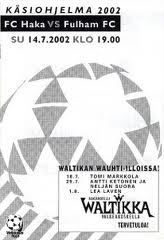Book Review: The Sad Story of Billy Callender by James (Jim) Wright
 “…it has always been said that goalkeepers are a breed apart – often extrovert but also prone to brooding introversion…”
“…it has always been said that goalkeepers are a breed apart – often extrovert but also prone to brooding introversion…”
Sadly this statement has come to carry significance in tragic circumstances on two occasions in recent years. Back in November 2009, Robert Enke, goalkeeper for Hannover 96 and a German international and just 32 years old, committed suicide by standing in front of a train at a level crossing in Eilvese on the outskirts of Hannover. After his death, his widow, Teresa, revealed that Enke had suffered from depression for six years and had struggled to come to terms with the death of their daughter, Lara in 2006. Enke’s story was captured in the 2011 William Hill Sports Book of the Year, titled, A Life Too Short by Ronald Reng. The tragedy touched the public in Germany and further afield. As a result, the German Football Association, the German Football League and Hannover 96 pledged to finance a Robert Enke Foundation, which would in future help with mental health issues of players.
Here in England in December 2010, 24 year old Rushden & Diamonds goalkeeper, Dale Roberts committed suicide. At the inquest details emerged that Roberts has killed himself after struggling to come to terms with an injury and national media speculation about his fiancee’s alleged affair with team-mate Paul Terry. Subsequently, his parents set up The Dale Roberts Memorial fund to help worthy causes including providing Christmas presents to children in a local hospital and helping youngsters off the streets and into football.
What struck me about whilst researching this article was firstly how readily available information is about the circumstances of these deaths, secondly that the suicides are seen as tragic and that lastly, the players memory is honoured through memorial funds and foundations, so that some good comes out of these sad events.
However, it has not always been thus. In The Sad Story of Billy Callender by James (Jim) Wright, the story of a goalkeeper who took his life in July 1932 is told. The adopted Billy Callender (real name Coulson) was originally from Prudhoe in Northumberland and worked briefly at the local colliery. Callender played for West Wylam Primitive Methodist Church, then Prudhoe Castle FC. Whilst here he was spotted and signed by Crystal Palace in October 1923, making his first team debut against South Shields in a 1-0 win on 22 March 1924. It wasn’t until the transfer of Jack Alderson to Sheffield United that Callender established himself in the first team at the start of the 1925-25 season in the Third Division (South). He was regarded as one of the “…most effective stoppers in the Football League…” and was selected to play for the Football League against The Army in 1926. In total, Callender played 225 matches for Crystal Palace and as an excellent servant to the club had a benefit match against the Combined Universities in April 1931. However, tragedy struck Callender when in May 1932, his long-term sweetheart and fiancée died from poliomyelitis. Callender travelled to his native North-East to visit family before returning to London in July 1932 for the start of the new season. On Monday 25 July Callender went to Selhurst Park “…to collect his registration papers and to confirm his health and fitness…” He didn’t report for training or the practice match arranged for the Tuesday, but he was found later that day hanged at the ground. At the inquest a verdict was returned that, “…Callender had taken his own life while of unsound mind…”, whilst the Croydon Advertiser wrote that Callender was “…inconsolable…” after the death of Ella.
Author Jim Wright makes some excellent observations towards the end of this book regarding attitudes at the time to suicide, “…death was seen essentially as a private matter – not an issue for too much public expression of grief…suicide was a taboo subject – indeed any attempt to take one’s own life, effective or otherwise, was deemed a criminal offence until as recently as 1961…” This sits at odds with how modern day society reacts (thankfully) to suicide. The author has carried out some wonderful research in writing this tribute to Billy Callender and to Ella, but acknowledges that so much information is just lost to the passages of time and which leave questions unanswered about Callender’s child-hood, his real parents, his brother and any therefore the ability to trace any possible descendants. However this doesn’t detract from this publication and Jim Wright should be proud that he has kept the memory of Billy Callender alive.
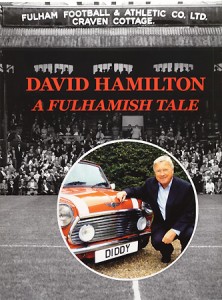 A Fulhamish Tale by David Hamilton is the latest offering from Ashwater Press. It is written by the broadcaster nicknamed “Diddy” and charts his life story in terms of his association with the club from Craven Cottage.
A Fulhamish Tale by David Hamilton is the latest offering from Ashwater Press. It is written by the broadcaster nicknamed “Diddy” and charts his life story in terms of his association with the club from Craven Cottage. It’s funny how at particular times in your life, little coincidences and things seem to come together. Take for instance the week that has gone by. Last Saturday evening I stepped off the stage after the last of four performances of the Agatha Christie play “And Then There Were None”. It’s a classic crime thriller set in 1930’s England, which despite a story-line which ultimately sees ten deaths, is all done in a language and manner that is not particularly dark or sinister, but is all rather wizard, what. Then the first book I find myself reviewing after my finishing at the theatre is from the stable of
It’s funny how at particular times in your life, little coincidences and things seem to come together. Take for instance the week that has gone by. Last Saturday evening I stepped off the stage after the last of four performances of the Agatha Christie play “And Then There Were None”. It’s a classic crime thriller set in 1930’s England, which despite a story-line which ultimately sees ten deaths, is all done in a language and manner that is not particularly dark or sinister, but is all rather wizard, what. Then the first book I find myself reviewing after my finishing at the theatre is from the stable of 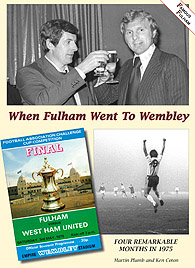
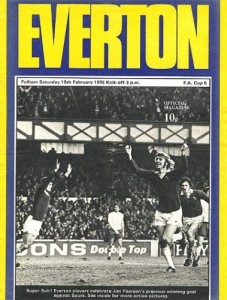
 Cup Final day itself is covered in glorious detail both in words and images, from the players being in the hotel in the morning, the journey to the Wembley, the pre-match build-up and the game itself. Of course, history tells us that there was no fairytale for Mullery and Moore and that feeling of deflation, almost anti-climax, after the game is something I can still remember. The book then closes with typical Ashwater Press attention to detail, as the story of 1975 is placed in context. There are memories from both Martin Plumb and Ken Coton of that incredible four months, as well as David Hamilton. A postscript and epilogue detail how just three years after the Cup Final only Les Strong remained at the club and the part a 20th Anniversary ‘replay’ between Fulham and West Ham had in raising much needed funds during the dark days of the mid-nineties. The ‘Where are they now?’ section is a joy as the reader discovers what happened to those heroes of 1975, but is tinged with sadness as ‘In Memoriam’ reminds us of those no longer with us who were involved in that incredible journey – Chappie D’Amato, Bill Taylor, Tommy Trinder, Bobby Moore, Ted Drake, Alec Stock and Roy Woolnough.
Cup Final day itself is covered in glorious detail both in words and images, from the players being in the hotel in the morning, the journey to the Wembley, the pre-match build-up and the game itself. Of course, history tells us that there was no fairytale for Mullery and Moore and that feeling of deflation, almost anti-climax, after the game is something I can still remember. The book then closes with typical Ashwater Press attention to detail, as the story of 1975 is placed in context. There are memories from both Martin Plumb and Ken Coton of that incredible four months, as well as David Hamilton. A postscript and epilogue detail how just three years after the Cup Final only Les Strong remained at the club and the part a 20th Anniversary ‘replay’ between Fulham and West Ham had in raising much needed funds during the dark days of the mid-nineties. The ‘Where are they now?’ section is a joy as the reader discovers what happened to those heroes of 1975, but is tinged with sadness as ‘In Memoriam’ reminds us of those no longer with us who were involved in that incredible journey – Chappie D’Amato, Bill Taylor, Tommy Trinder, Bobby Moore, Ted Drake, Alec Stock and Roy Woolnough. Back in February 2011,
Back in February 2011, 
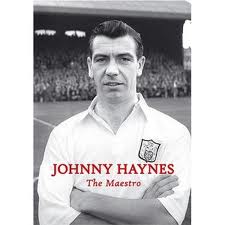 As a football fan, there are games and players from the past that you wish you had been able to see. For me attempting to pick just one Fulham fixture where I wish I could have attended is a mightily difficult task. However, when it comes to the player I most wish I could have seen, well that it a different matter – quite simply, John Norman (Johnny) Haynes. The Maestro played his last first team game at Craven Cottage on Saturday 17 January 1970 against Stockport County. It wasn’t until two years later that I made my first visit to The Cottage, by which time Johnny was gracing the football fields of South Africa. Therefore in reading and reviewing this book I make no apology that I have done so as very much a Fulham fan and with an eagerness to discover so much more about this legend.
As a football fan, there are games and players from the past that you wish you had been able to see. For me attempting to pick just one Fulham fixture where I wish I could have attended is a mightily difficult task. However, when it comes to the player I most wish I could have seen, well that it a different matter – quite simply, John Norman (Johnny) Haynes. The Maestro played his last first team game at Craven Cottage on Saturday 17 January 1970 against Stockport County. It wasn’t until two years later that I made my first visit to The Cottage, by which time Johnny was gracing the football fields of South Africa. Therefore in reading and reviewing this book I make no apology that I have done so as very much a Fulham fan and with an eagerness to discover so much more about this legend. It is interesting to reflect that with Fulham having been promoted to the First Division and Haynes made England captain during the 1959/60 season that all seemed right with the world. However, it could be seen as the start of a period of struggle for Fulham which obviously had an impact on its captain and focal point. From this season onwards each year The Cottagers battled relegation from the top flight until in 1967/68 they ran out of luck. During that time much happened to Johnny Haynes. In terms of his England career, his finest hour came on April 15 1961 when he led England to an astonishing 9-3 victory over Scotland at Wembley. He then experienced his second World Cup Finals tournament in Chile in 1962. However, England departed at the Quarter Final stage 3-1 to Brazil. He very much split the football critics of the time, with opinion divided on whether Haynes was the right man around which England should play.
It is interesting to reflect that with Fulham having been promoted to the First Division and Haynes made England captain during the 1959/60 season that all seemed right with the world. However, it could be seen as the start of a period of struggle for Fulham which obviously had an impact on its captain and focal point. From this season onwards each year The Cottagers battled relegation from the top flight until in 1967/68 they ran out of luck. During that time much happened to Johnny Haynes. In terms of his England career, his finest hour came on April 15 1961 when he led England to an astonishing 9-3 victory over Scotland at Wembley. He then experienced his second World Cup Finals tournament in Chile in 1962. However, England departed at the Quarter Final stage 3-1 to Brazil. He very much split the football critics of the time, with opinion divided on whether Haynes was the right man around which England should play.

 The first thing that struck me about this book is the title. In football terms it is a bit of a ‘game of two halves’. The main title, “…Glory, Goals & Greed…” has a tabloid feel about it, whilst the sub-title, “…Twenty Years of the Premier League…” is a factual statement.
The first thing that struck me about this book is the title. In football terms it is a bit of a ‘game of two halves’. The main title, “…Glory, Goals & Greed…” has a tabloid feel about it, whilst the sub-title, “…Twenty Years of the Premier League…” is a factual statement.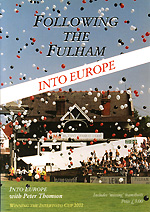 Ashwater Press is an independent book publisher which essentially produces publications featuring Fulham Football Club. The driving forces behind the enterprise are Ken Coton and Martin Plumb. Amongst the array of Ashwater Press titles are the following,
Ashwater Press is an independent book publisher which essentially produces publications featuring Fulham Football Club. The driving forces behind the enterprise are Ken Coton and Martin Plumb. Amongst the array of Ashwater Press titles are the following, 